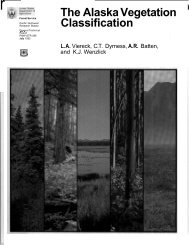Lesson 3: Species in the environmental complex
Lesson 3: Species in the environmental complex
Lesson 3: Species in the environmental complex
Create successful ePaper yourself
Turn your PDF publications into a flip-book with our unique Google optimized e-Paper software.
Bill<strong>in</strong>gs: Groups of factors <strong>in</strong> a terrestrial plant environment:<br />
– Climate<br />
– Edaphic<br />
– Geographic<br />
– Topographic<br />
– Pyric<br />
– Biotic<br />
Groups were subdivided <strong>in</strong>to: factors subfactors and aspects.<br />
Examples:<br />
Climate was divided <strong>in</strong>to <strong>the</strong> factors Radiation, Temperature, Water, Atmospheric gases.<br />
Edaphic was divided <strong>in</strong>to Parent material, Soil;<br />
Geographic was divided <strong>in</strong>to Gravity, Rotational Effects, Geographic Position,<br />
Vulcanism, Ditrophism (fold<strong>in</strong>g, fault<strong>in</strong>g), Erosion and Deposition, Topography, etc.<br />
The factor Radiation was divided <strong>in</strong>to <strong>the</strong> subfactors: Solar radiation, cosmic radiation, and<br />
terrestrial radiation.<br />
The subfactor Solar radiation was subdivided <strong>in</strong> <strong>the</strong> aspects, wavelenths, <strong>in</strong>tensity,<br />
photoperiod and o<strong>the</strong>r cycles.<br />
Bill<strong>in</strong>gs identified a total of 64 <strong>environmental</strong> aspects, but this was by no means a<br />
comprehensive list. It only served to illustrate how <strong>complex</strong> <strong>the</strong> plant environment is and<br />
how <strong>the</strong> aspects <strong>in</strong>teract among <strong>the</strong>mselves and <strong>the</strong> plant.
















